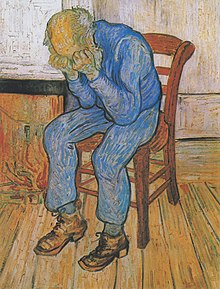 Global Information
Global InformationMajor depressive disorder information
| Major depressive disorder | |
|---|---|
| Other names | Clinical depression, major depression, unipolar depression, unipolar disorder, recurrent depression |
 | |
| Sorrowing Old Man (At Eternity's Gate), an 1890 portrait by Vincent van Gogh | |
| Specialty | Psychiatry, clinical psychology |
| Symptoms | Low mood, low self-esteem, loss of interest in normally enjoyable activities, low energy, pain without a clear cause,[1] disturbed sleep pattern (insomnia or hypersomnia) |
| Complications | Self-harm, suicide[2] |
| Usual onset | Age 20s[3][4] |
| Duration | > 2 weeks[1] |
| Causes | Environmental (e.g. adverse life experiences), genetic predisposition, psychological factors such as stress[5] |
| Risk factors | Family history, major life changes, certain medications, chronic health problems, substance use disorder[1][5] |
| Differential diagnosis | Bipolar disorder, ADHD, sadness[6] |
| Treatment | Psychotherapy, antidepressant medication, electroconvulsive therapy, transcranial magnetic stimulation, exercise[1][7] |
| Medication | Antidepressants |
| Frequency | 163 million (2017)[8] |
Major depressive disorder (MDD), also known as clinical depression, is a mental disorder[9] characterized by at least two weeks of pervasive low mood, low self-esteem, and loss of interest or pleasure in normally enjoyable activities. Introduced by a group of US clinicians in the mid-1970s,[10] the term was adopted by the American Psychiatric Association for this symptom cluster under mood disorders in the 1980 version of the Diagnostic and Statistical Manual of Mental Disorders (DSM-III), and has become widely used since.
The diagnosis of major depressive disorder is based on the person's reported experiences, behavior reported by relatives or friends, and a mental status examination.[11] There is no laboratory test for the disorder, but testing may be done to rule out physical conditions that can cause similar symptoms.[11] The most common time of onset is in a person's 20s,[3][4] with females affected about twice as often as males.[4] The course of the disorder varies widely, from one episode lasting months to a lifelong disorder with recurrent major depressive episodes.
Those with major depressive disorder are typically treated with psychotherapy and antidepressant medication.[1] Medication appears to be effective, but the effect may be significant only in the most severely depressed.[12][13] Hospitalization (which may be involuntary) may be necessary in cases with associated self-neglect or a significant risk of harm to self or others. Electroconvulsive therapy (ECT) may be considered if other measures are not effective.[1]
Major depressive disorder is believed to be caused by a combination of genetic, environmental, and psychological factors,[1] with about 40% of the risk being genetic.[5] Risk factors include a family history of the condition, major life changes, certain medications, chronic health problems, and substance use disorders.[1][5] It can negatively affect a person's personal life, work life, or education, and cause issues with a person's sleeping habits, eating habits, and general health.[1][5] Major depressive disorder affected approximately 163 million people (2% of the world's population) in 2017.[8] The percentage of people who are affected at one point in their life varies from 7% in Japan to 21% in France.[4] Lifetime rates are higher in the developed world (15%) compared to the developing world (11%).[4] The disorder causes the second-most years lived with disability, after lower back pain.[14]
- ^ a b c d e f g h i "Depression". U.S. National Institute of Mental Health (NIMH). May 2016. Archived from the original on 5 August 2016. Retrieved 31 July 2016.
- ^ Cite error: The named reference
Rich2014was invoked but never defined (see the help page). - ^ a b American Psychiatric Association 2013, p. 165.
- ^ a b c d e Kessler RC, Bromet EJ (2013). "The epidemiology of depression across cultures". Annual Review of Public Health. 34: 119–38. doi:10.1146/annurev-publhealth-031912-114409. PMC 4100461. PMID 23514317.
- ^ a b c d e American Psychiatric Association 2013, p. 166.
- ^ American Psychiatric Association 2013, pp. 167–168.
- ^ Cooney GM, Dwan K, Greig CA, Lawlor DA, Rimer J, Waugh FR, McMurdo M, Mead GE (September 2013). Mead GE (ed.). "Exercise for depression". The Cochrane Database of Systematic Reviews. 2013 (9): CD004366. doi:10.1002/14651858.CD004366.pub6. PMC 9721454. PMID 24026850.
- ^ a b GBD 2017 Disease and Injury Incidence and Prevalence Collaborators (10 November 2018). "Global, regional, and national incidence, prevalence, and years lived with disability for 354 diseases and injuries for 195 countries and territories, 1990–2017: a systematic analysis for the Global Burden of Disease Study 2017". Lancet. 392 (10159): 1789–1858. doi:10.1016/S0140-6736(18)32279-7. PMC 6227754. PMID 30496104.
- ^ Sartorius N, Henderson AS, Strotzka H, et al. "The ICD-10 Classification of Mental and Behavioural Disorders Clinical descriptions and diagnostic guidelines" (PDF). World Health Organization. Archived from the original (PDF) on 5 February 2022. Retrieved 23 June 2021.
- ^ Spitzer RL, Endicott J, Robins E (1975). "The development of diagnostic criteria in psychiatry" (PDF). Archived (PDF) from the original on 14 December 2005. Retrieved 8 November 2008.
- ^ a b Patton LL (2015). The ADA Practical Guide to Patients with Medical Conditions (2nd ed.). John Wiley & Sons. p. 339. ISBN 978-1-118-92928-5.
- ^ Fournier JC, DeRubeis RJ, Hollon SD, Dimidjian S, Amsterdam JD, Shelton RC, Fawcett J (January 2010). "Antidepressant drug effects and depression severity: a patient-level meta-analysis". JAMA. 303 (1): 47–53. doi:10.1001/jama.2009.1943. PMC 3712503. PMID 20051569.
- ^ Kirsch I, Deacon BJ, Huedo-Medina TB, Scoboria A, Moore TJ, Johnson BT (February 2008). "Initial severity and antidepressant benefits: a meta-analysis of data submitted to the Food and Drug Administration". PLOS Medicine. 5 (2): e45. doi:10.1371/journal.pmed.0050045. PMC 2253608. PMID 18303940.
- ^ Global Burden of Disease Study 2013 Collaborators (August 2015). "Global, regional, and national incidence, prevalence, and years lived with disability for 301 acute and chronic diseases and injuries in 188 countries, 1990–2013: a systematic analysis for the Global Burden of Disease Study 2013". Lancet. 386 (9995): 743–800. doi:10.1016/S0140-6736(15)60692-4. PMC 4561509. PMID 26063472.